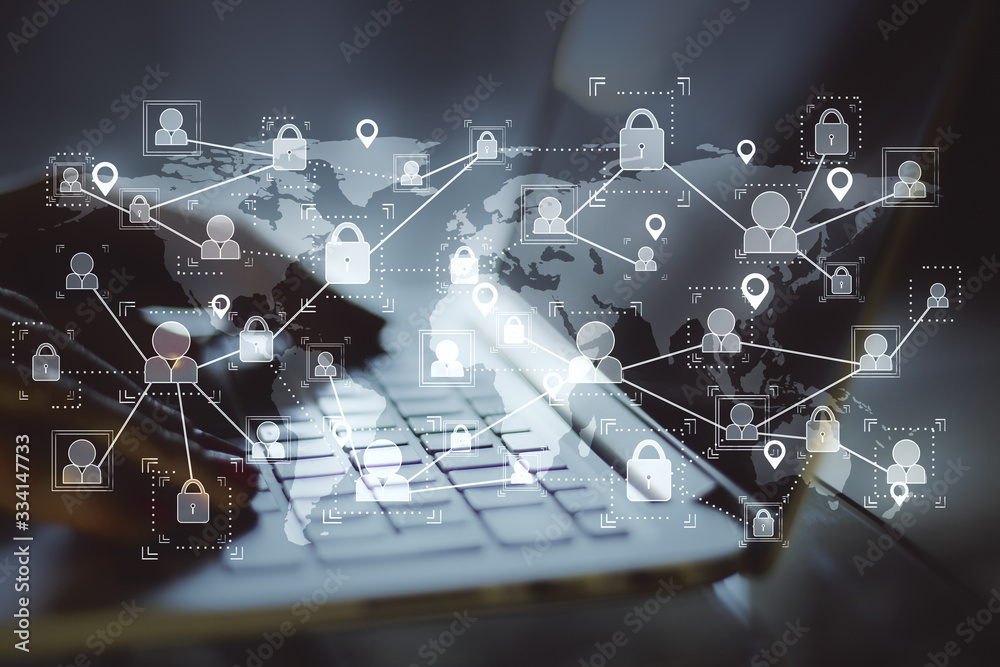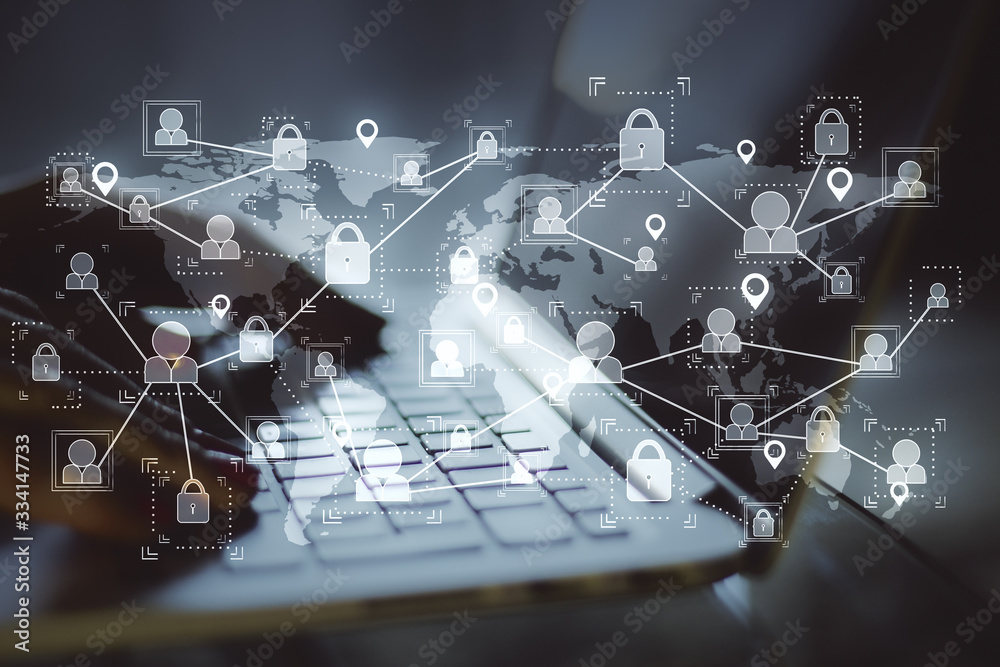The Future of Cybersecurity: Predictions And Insights For Network Protection
In our digitized age, where the boundaries between the virtual and the tangible continue to blur, the significance of cybersecurity has escalated to unprecedented levels. As we traverse an era of unparalleled technological advancements, our lives have become intricately interwoven with the digital realm. Whether it’s the data we share, the transactions we make, or the systems we rely upon, everything seems to be interconnected through the intricate web of networks. This profound interconnectivity has granted us boundless opportunities, but it has also exposed us to a multitude of vulnerabilities that can be exploited by malicious actors. This is where the realm of cybersecurity steps in a fortress of defense against the ever-evolving landscape of digital threats.
The growth of our digital footprint has been astonishing, with smart devices becoming omnipresent and cloud-based services becoming ubiquitous. As we entrust our personal information, financial details, and even critical infrastructure to the digital realm, the stakes have never been higher. The repercussions of a cyberattack can reverberate through every aspect of our lives, from privacy breaches to economic disruptions and even potential threats to national security. Consequently, the importance of safeguarding our digital assets has risen to the forefront of global concerns.
As we navigate the ever-evolving landscape of technology, our understanding of cybersecurity must be equally agile. In the pages that follow, we will delve into predictions and insights that illuminate the path ahead. From the potential emergence of AI-driven cyberattacks to the promise of quantum-resistant encryption, the future of network protection holds both challenges and remarkable solutions that will shape the way we interact with our digital world. We uncover the strategies that will define the future of cybersecurity and ensure a safer, more secure digital future for all.
Current State of Cybersecurity

Overview
In the rapidly evolving landscape of technology and connectivity, the current state of cybersecurity is a complex tapestry of challenges and countermeasures. As our digital footprint expands, so does the realm of potential threats, and the cybersecurity community finds itself engaged in a perpetual battle to stay ahead of malicious actors seeking to exploit vulnerabilities.
One of the prominent challenges in the realm of cybersecurity is the proliferation of sophisticated malware attacks. Traditional malware has transformed into stealthier, adaptive variants that can evade detection and spread rapidly across networks. Phishing attacks continue to be a significant threat, exploiting human psychology rather than technical vulnerabilities. Cybercriminals craft convincing emails, messages, or websites to deceive individuals into revealing sensitive information or performing actions that compromise security.
Zero-day vulnerabilities are undisclosed software flaws that attackers exploit before vendors can release patches. These vulnerabilities give attackers a window of opportunity to infiltrate systems, steal data, or cause damage. State-sponsored cyberattacks have escalated, posing serious threats to national security and geopolitical stability. These attacks are often highly sophisticated and target critical infrastructure, government agencies, and corporations.
The current state of cybersecurity is characterized by an intricate interplay between rapid technological advancements and the escalating sophistication of cyber threats. As we continue to embrace the benefits of a connected world, it is imperative that cybersecurity strategies evolve in tandem to safeguard our digital lives and ensure the integrity of the networks that underpin modern society.
Technologies and Methods in Use
In the relentless battle against cyber threats, cybersecurity practitioners employ an array of technologies and methodologies to fortify network protection. These tools and approaches are designed to detect, prevent, and mitigate various forms of cyberattacks. However, while they offer significant benefits, they also come with certain limitations that underscore the dynamic and ever-evolving nature of the cybersecurity landscape.
Firewalls and Intrusion Detection/Prevention Systems
Firewalls remain a cornerstone of network security by acting as a barrier between trusted and untrusted networks. They inspect incoming and outgoing traffic, allowing or blocking data based on predefined rules. Intrusion Detection Systems (IDS) and Intrusion Prevention Systems (IPS) extend this functionality by actively monitoring network traffic for suspicious patterns and behavior, either alerting administrators or taking automated actions to thwart attacks.
Antivirus and Anti-Malware Software
Antivirus and anti-malware solutions scan files and systems for known patterns of malicious code, preventing infections from well-established threats. However, these tools often rely on signature-based detection, which can lag behind emerging threats or those employing polymorphic code that changes its form to evade detection. As a result, zero-day attacks and sophisticated malware can slip through the cracks.
Encryption and Secure Communications
Encryption plays a pivotal role in protecting data in transit and at rest. Secure Sockets Layer (SSL) and Transport Layer Security (TLS) protocols ensure encrypted communication between users and websites. While encryption adds a layer of confidentiality, attackers may exploit implementation weaknesses or focus on attacking endpoints or the encryption infrastructure itself.
Multi-Factor Authentication (MFA)
MFA enhances security by requiring users to provide multiple forms of verification before granting access. This approach mitigates the risk of unauthorized access, even if login credentials are compromised. However, while effective, MFA adoption can be challenging due to usability concerns and the need for infrastructure support.
Penetration Testing and Red Teaming
Ethical hacking through penetration testing and red teaming involves simulating real-world attacks to identify vulnerabilities in networks and systems. While invaluable for identifying weaknesses, these approaches provide a snapshot of security posture at a specific point in time and may not cover all potential attack vectors.
Effectiveness and Limitations
The technologies and methods discussed offer crucial layers of defense against a wide array of cyber threats. However, their effectiveness is not universal, and limitations exist. The rapid evolution of attack techniques and the emergence of sophisticated threats can outpace the capabilities of traditional security measures. Additionally, the complexity of modern networks and the sheer volume of data generated challenge the ability to accurately detect and respond to threats in real time. Human error, lack of awareness, and misconfigurations can also undermine even the most advanced security systems.
As organizations strive to strike a balance between security and usability, the integration of multiple defense layers and a proactive, adaptive approach to cybersecurity are becoming imperative. The future of network protection lies in the synergy of these technologies and methodologies, continuously evolving to match the dynamic nature of cyber threats.
Predictions for the Future
Emerging Technologies
The future of cybersecurity holds a promise of innovative technologies that will redefine how we protect our networks and digital assets. These emerging technologies are poised to revolutionize the way we approach network protection, enabling us to stay ahead of increasingly sophisticated cyber threats.
Artificial Intelligence (AI) and Machine Learning (ML)
AI and ML are set to play a pivotal role in the future of cybersecurity. These technologies can analyze vast amounts of data to identify patterns and anomalies that might go unnoticed by traditional methods. AI-powered systems can learn from previous attacks, adapt to new tactics, and make real-time decisions, enhancing the efficiency and accuracy of threat detection and response.
Zero Trust Architecture
The Zero Trust model challenges the traditional perimeter-based security approach. Instead of relying solely on a trusted internal network, Zero Trust assumes that threats can originate from within and outside the network. It enforces strict access controls and verification mechanisms for every user and device, reducing the attack surface and mitigating the impact of potential breaches.
Quantum-Resistant Encryption
As quantum computing advances, traditional encryption methods could become vulnerable to quantum attacks. Quantum-resistant encryption techniques leverage the principles of quantum mechanics to create encryption algorithms that are resistant to quantum-powered decryption attempts, ensuring the continued confidentiality of data.
Homomorphic Encryption
Homomorphic encryption allows computations to be performed on encrypted data without the need to decrypt it. This technology holds the potential to enable secure data processing in scenarios like cloud computing, where data privacy is a concern. It could revolutionize how sensitive information is shared and processed while maintaining strong security.
Post-Quantum Cryptography
In anticipation of the threat posed by quantum computing, post-quantum cryptography seeks to develop encryption algorithms that remain secure even in the face of quantum attacks. As quantum computers become more powerful, these algorithms will be essential to safeguarding sensitive information from potential breaches.
Blockchain and Distributed Ledger Technology
Blockchain’s decentralized nature and cryptographic security make it a potential asset in cybersecurity. It can be used for secure identity verification, tamper-proof logging, and secure data sharing. Its application in supply chain security, digital identity, and secure transactions could revolutionize network protection.
Changing Threat Landscape
As technology continues its rapid evolution, the cyber threat landscape is expected to undergo profound changes, introducing new types of threats and altering the nature of existing ones. Anticipating these changes is essential for proactive cybersecurity preparedness.
AI-Driven Attacks
The rise of artificial intelligence may herald a new era of AI-driven cyberattacks. Attackers could use AI to automate the identification of vulnerabilities, craft sophisticated phishing attacks, or generate convincing deepfake content to manipulate individuals or organizations. AI-powered attacks may be capable of adapting in real time, making them challenging to detect and mitigate.
Ransomware Evolution
Ransomware attacks are likely to become even more targeted and damaging. Cybercriminals could combine ransomware with data theft, threatening not only to encrypt victims’ data but also to leak sensitive information unless a ransom is paid. This dual threat could exponentially increase the consequences of a successful attack, affecting both financial stability and reputation.
Supply Chain Vulnerabilities
The interconnected nature of supply chains presents a ripe target for cyber attackers. Breaching a single link in the chain can have cascading effects on multiple organizations. Attackers may focus on compromising suppliers or using them as a vector to infiltrate larger organizations, posing significant challenges for ensuring the security of the entire ecosystem.
Internet of Things (IoT) Exploitation
As the number of IoT devices continues to grow, so does the potential attack surface. Insecure IoT devices can be weaponized to launch large-scale distributed denial-of-service (DDoS) attacks, infiltrate networks, and even compromise critical infrastructure. Strengthening IoT security will be crucial to prevent these vulnerabilities from being exploited.
Biometric Data Breaches
As biometric authentication becomes more common, the theft of biometric data (such as fingerprints, facial recognition patterns, or iris scans) could become a significant threat. Unlike passwords, biometric data cannot be changed, making breaches irreversible and raising concerns about privacy and identity theft.
Regulation and Compliance
The evolving cybersecurity landscape is likely to be accompanied by changes in laws and regulations aimed at addressing new and emerging threats. These regulatory shifts will significantly influence how organizations approach cybersecurity strategies and technologies.
Stricter Data Protection Law
As data breaches and privacy concerns continue to escalate, governments are expected to enact stricter data protection laws. Organizations will face more rigorous requirements for data collection, storage, and processing. Compliance will demand enhanced security measures, data encryption, and robust breach notification protocols to protect user information.
Cross-Border Data Flow Regulations
With the global nature of cyber threats, regulations surrounding cross-border data flows are likely to evolve. Nations may enforce data localization rules to ensure that citizens’ data remains within their borders, leading to challenges for multinational organizations in managing data securely while adhering to various jurisdictions.
Liability and Accountability
Regulatory frameworks may shift to emphasize accountability and liability for cybersecurity breaches. Organizations may be required to demonstrate due diligence in safeguarding sensitive information and promptly reporting breaches. Failure to comply could lead to substantial fines and reputational damage.
Industry-Specific Regulations
Certain industries, such as critical infrastructure, healthcare, and financial services, are particularly vulnerable to cyber threats. Anticipate specialized regulations tailored to these sectors, stipulating specific cybersecurity measures to mitigate unique risks.
Certification and Compliance Standards
Standardized certification and compliance frameworks could emerge to help organizations demonstrate their cybersecurity posture. These frameworks may be industry-specific or universal, providing a benchmark for cybersecurity maturity and enabling better risk assessment for stakeholders.
Insights for Network Protection

Strategies for Protection
Effectively safeguarding networks requires a multifaceted approach that combines advanced technologies with well-defined policies and practices. Below are insights into strategies that organizations can adopt to enhance network protection.
Multi-Layered Defense
Implement a multi-layered defense approach that combines various security technologies, such as firewalls, intrusion detection systems, and endpoint protection. This approach minimizes the chances of a single point of failure and ensures that if one layer is breached, others are still intact to provide protection.
Zero Trust Architecture
Transition to a Zero Trust architecture that emphasizes identity and access management. Authenticate and authorize users, devices, and applications at every interaction, regardless of their location or network connection, reducing the risk of unauthorized access.
Regular Patching and Updates
Ensure that all software, operating systems, and applications are promptly patched and updated. Many cyberattacks exploit known vulnerabilities, and patching these vulnerabilities is a critical defense measure.
Network Segmentation
Segment the network into isolated zones, restricting lateral movement for attackers. This approach contains breaches and limits the scope of potential damage in case of an intrusion.
User Training and Awareness
Educate employees about cybersecurity best practices, including recognizing phishing attempts, avoiding risky behavior, and reporting suspicious activities. A security-conscious workforce acts as a strong first line of defense.
Incident Response Planning
Develop a comprehensive incident response plan that outlines roles, responsibilities, and procedures in case of a security breach. Regularly test and update this plan to ensure it remains effective.
Data Encryption
Implement end-to-end encryption for sensitive data, both in transit and at rest. Encryption adds a layer of protection even if attackers gain access to the data.
Importance of Education and Training
Education plays a pivotal role in cultivating a cybersecurity mindset among employees. Encourage a culture where security is everyone’s responsibility, from the C-suite to the frontline staff. Cyber threats evolve rapidly, making continuous training essential. Regularly update employees on the latest threat trends, attack techniques, and mitigation strategies to keep them informed and vigilant. Conduct phishing simulations to test employees’ ability to identify suspicious emails.
This hands-on approach helps reinforce the importance of scrutinizing communications before taking action. Tailor training to different roles within the organization. IT staff may need technical training, while non-technical employees might benefit from training on secure browsing habits and password hygiene. Organize practical workshops and simulated incident response drills to give employees hands-on experience in handling security incidents. These exercises build confidence and readiness. Collaborate with cybersecurity experts and organizations to provide specialized training and insights. External perspectives can offer fresh insights into evolving threat landscapes.
By prioritizing education and continuous training, organizations empower their workforce to become proactive defenders against cyber threats. This human-centric approach complements technological measures, creating a robust network protection strategy that adapts to the evolving threat landscape.
Case Studies and Examples
Australian Signals Directorate (ASD) and the Essential Eight:
The ASD, Australia’s national signals intelligence and information security agency, introduced the “Essential Eight” cybersecurity mitigation strategies. These strategies focus on mitigating a range of cyber threats, including targeted attacks and ransomware. They include application whitelisting, patching applications, configuring Microsoft Office macro settings, restricting administrative privileges, and implementing multi-factor authentication, among others. The ASD found that these strategies could prevent up to 85% of targeted cyber intrusions. This case demonstrates that a comprehensive and proactive approach can significantly enhance network protection.
Data Breach at the Australian National University (ANU):
In 2018, the ANU experienced a significant data breach that exposed personal and financial information of staff, students, and visitors. The breach underscored the need for stringent network protection measures, even in educational institutions. The incident prompted the university to bolster its cybersecurity practices, enhance incident response capabilities, and strengthen its focus on cybersecurity education and awareness. This case illustrates the real-world consequences of insufficient network protection and the importance of a robust security posture.
In Canberra’s context, these case studies exemplify the importance of a holistic and adaptable approach to network protection. By drawing lessons from successful strategies and real-world incidents, organizations can strengthen their defenses against cyber threats and contribute to a more secure digital environment.
Preparing for the Future

Best Practices
Future-proofing against cybersecurity threats requires a proactive and holistic approach that combines technological measures, policy enforcement, and user education. Here are best practices that can be implemented across various contexts.
Regular Training and Awareness
Conduct regular cybersecurity training for employees, emphasizing the evolving threat landscape, social engineering tactics, and safe online behavior. Inculcate a security-conscious culture that permeates all levels of an organization.
Multi-Layered Defense
Implement a multi-layered security strategy that encompasses network, endpoint, application, and user-level defenses. This approach minimizes single points of failure and provides multiple opportunities to detect and thwart threats.
Zero Trust Architecture
Adopt a Zero Trust model that verifies and authenticates every user, device, and application attempting to access the network. This approach minimizes the risk of lateral movement in case of a breach.
Encryption
Employ strong encryption for data at rest and in transit. This prevents unauthorized access to sensitive information, even if the data is intercepted.
Potential Challenges
Implementing robust cybersecurity measures might be resource-intensive. Smaller organizations may struggle to allocate sufficient resources for comprehensive protection. Employees and stakeholders might resist changes in workflows or the adoption of new security practices. Overcoming this resistance requires effective communication and training. As technology evolves, new threats and vulnerabilities emerge. Keeping up with these changes and ensuring that security measures remain relevant can be challenging. Striking the right balance between security and usability is crucial. Overly restrictive security measures might hinder productivity and user satisfaction.
Recommendations
For individuals, stay informed about cybersecurity trends and best practices. Use strong, unique passwords and enable multi-factor authentication for accounts. Be cautious of unsolicited communications and avoid clicking on suspicious links.
For businesses, invest in cybersecurity as a business priority, allocating sufficient resources for protection. Implement a cybersecurity framework that combines technological solutions, employee training, and incident response planning.
For governments, enact and enforce robust cybersecurity regulations that incentivize organizations to prioritize security. Foster collaboration between public and private sectors to share threat intelligence and best practices.
Conclusion
As we conclude this exploration of the cybersecurity landscape, a resounding truth emerges, the importance of staying ahead has never been more crucial. In a world where technology advances at an unprecedented pace and cyber threats grow increasingly sophisticated, complacency is not an option. The evolving nature of cyberattacks, the emergence of new vulnerabilities, and the rapid integration of digital systems into our lives demand our unwavering commitment to proactive defense.
The road ahead may be challenging, but it is navigable. By embracing change, fostering innovation, and prioritizing cybersecurity at all levels of society, we can build a safer digital landscape for ourselves and future generations. The world of tomorrow will belong to those who understand that in cybersecurity, as in life, the future rewards those who dare to stay ahead.
In an era where staying ahead is paramount, TechBox not only anticipates threats but also pioneers innovative solutions. For those seeking unparalleled security and peace of mind, TechBox is the definitive choice—a steadfast partner in safeguarding the digital future of Canberra and beyond. Contact us today for the best secure.










